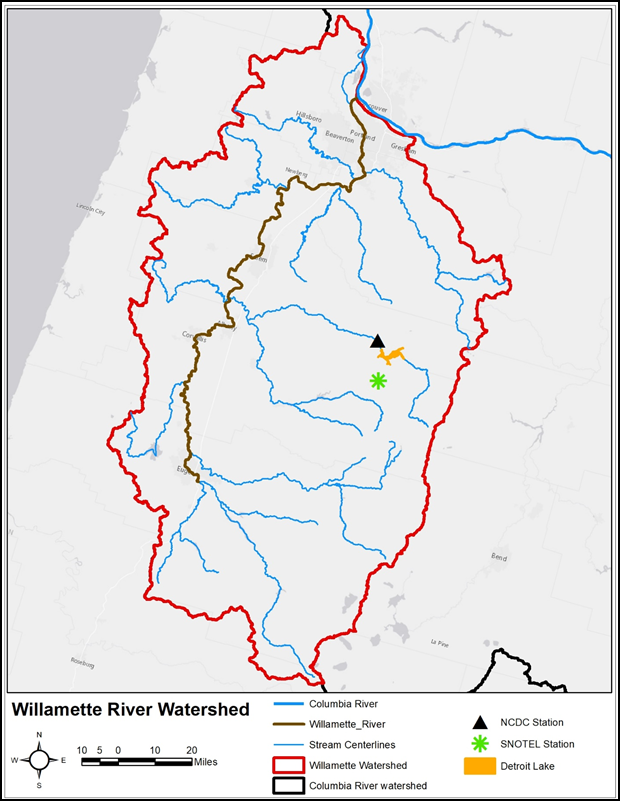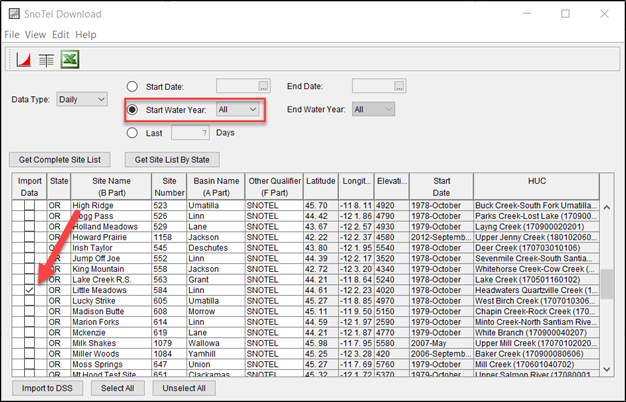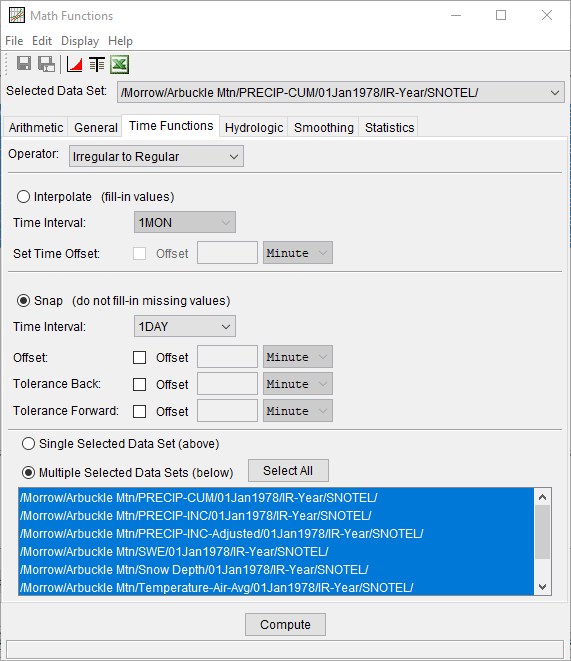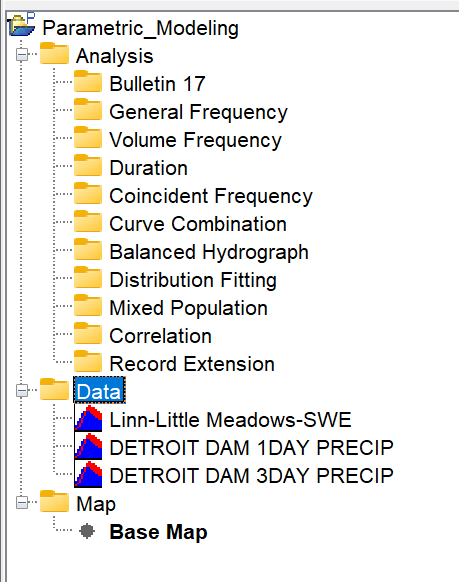Download PDF
Download page Task 1. Create a new HEC-SSP Study and Import Multiple Data Sets.
Task 1. Create a new HEC-SSP Study and Import Multiple Data Sets
Software Version
HEC-SSP version 2.3.1 was used to created this tutorial. You will need to use HEC-SSP version 2.3.1 to open the project files: https://www.hec.usace.army.mil/software/hec-ssp/download.aspx.
Download the data file here: Detroit_Dam_Precipitation.dss
The first step in performing a frequency analysis within HEC-SSP is to establish which directory you wish to work in and to enter a title for the new study.
- Create a new HEC-SSP study.
- Name this project “Parametric_Modeling”.
- Leave the Unit System and Coordinate System set to their default values of English and Geographic, respectively.
Before any analyses can be performed, data must be imported to the HEC-SSP study. Within this study, you will utilize data for a National Weather Service (NWS) precipitation gage located at Detroit Dam as well as a Natural Resource Conservation Service (NRCS) Snow Telemetry (SNOTEL) station located near Detroit Dam. The locations of these data sources in relation to Detroit Dam is shown in Figure 1. This data must be imported using HEC-DSSVue plugins.

First, you will import data using the SNOTEL plugin.
- Click Tools | HEC-DSSVue to launch HEC-DSSVue. This will create a new DSS file for use in the study. Click OK to any windows that are shown informing you of this file creation.
- Within HEC-DSSVue, click Data Entry | Import | SnoTel to launch the SNOTEL plugin editor.
- Click the Get Site List by State button.
- Select Oregon and click OK to search for all SNOTEL stations within Oregon.
- Find the Little Meadows SNOTEL station and click the check box within the Import Data column.
- Select the Start Water Year radio button near the top of the editor and ensure the All selection is made within the drop down menu. Leave all other options set to the default values.
- The SNOTEL editor should appear similar to Figure 2.

- Click the Import to DSS button at the bottom of the editor to import the data.
- Click OK within the pop up window that will be shown to inform you that the data was downloaded successfully.
- Close the SNOTEL editor by clicking on the “X” in the upper right corner of the editor. You should notice 9 new records (8 that contain time series data and one containing X-Y-Z data) within the DSS file.
If the data was downloaded with an E-Part of IR-YEAR, it must be converted to use an E-Part of 1DAY for the subsequent analyses.
- Select the E-part drop down menu and select "IR-YEAR". This will select all data sets with this E-part.
- Select all of the "IR-YEAR" data sets.
- Click Tools | Math Functions to open the Math Functions editor.
- Select the Time Functions tab.
- Change the Operator to Irregular to Regular.
- Select the Snap (do not fill in missing values) radio button.
- Change the Time Interval to 1DAY.
- Select the Multiple Selected Data Sets radio button and click the Select All button. The Math Functions editor should resemble Figure 3.

- Click the Compute button.
- Click the Save button (
 ).
). - Close the Math Functions editor by clicking the "X" in the upper right hand corner of the window.
Now, you must import the SNOTEL data to the HEC-SSP study.
- Close the HEC-DSSVue editor by clicking on the “X” in the upper right hand corner of the window.
- Within HEC-SSP, click Data | New | Using Import Wizard to open the new Data Importer Wizard.
- Click the Next button.
- Change the Source to HEC-DSS and click the Next button.
- Click the ellipsis button within the Selected DSS File entry field.
- Within the pop up window, navigate to and select the study DSS file that was just edited (i.e. Parametric_Modeling.dss). Click Open to select this file. This will cause the contents of the selected DSS file to populate within the table listing selectable data sets.
Double left click on the “/Linn/Little Meadows/SWE//1DAY/SNOTEL/” data set to add it to the window at the bottom of the Data Importer.
Ensure that you selected the SWE time series!
- Click Next and review your data one last time.
- When ready, click Import to to import the data set and return to the main HEC-SSP desktop.
- Click the Save button (
 ) to save the study.
) to save the study.
Now, you must import the NWS precipitation data to the HEC-SSP study. This information has already been loaded into a DSS file for you. However, this information can be easily ingested to a DSS file using the NCDC plugin as described within the Introduction to HEC-SSP Task 6. Import Data using an HEC-DSSVue Plugin tutorial.
- Click Data | New | Using Import Wizard to open the new Data Importer Wizard.
- Click the Next button.
- Change the Source to HEC-DSS and click the Next button.
- Click the ellipsis button within the Selected DSS File entry field.
- Within the pop up window, navigate to and select the Detroit_Dam_Precipitation.dss file.
- Click Open to select this file. This will cause two records to populate within the table listing selectable data sets.
Double left click on both data sets to add them to the window at the bottom of the Data Importer.
Ensure that you selected both time series!
- Click Next and review your data one last time.
- When ready, click Import to to import the data set and return to the main HEC-SSP desktop.
- Edit the metadata for both precipitation data sets to better identify them as either the 1-day or 3-day time series. The Study Explorer should appear similar to Figure 4.
- Click the Save button to save the study.

Continue to Task 2. Analyze the Data.